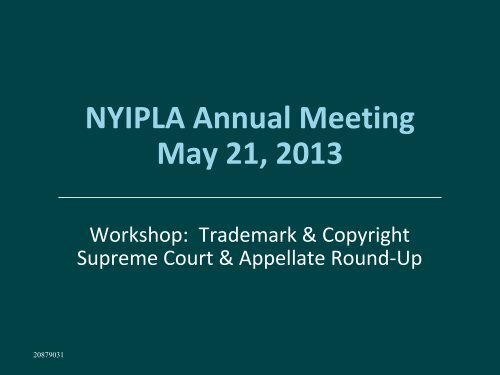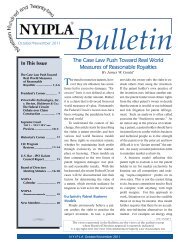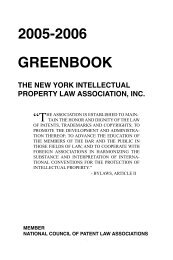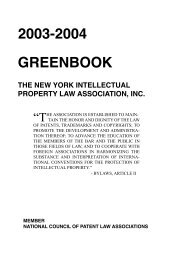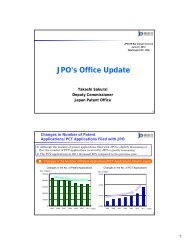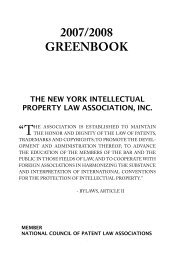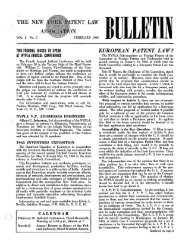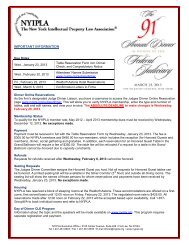Survival of the Presumption of Irreparable Harm - NYIPLA
Survival of the Presumption of Irreparable Harm - NYIPLA
Survival of the Presumption of Irreparable Harm - NYIPLA
Create successful ePaper yourself
Turn your PDF publications into a flip-book with our unique Google optimized e-Paper software.
<strong>NYIPLA</strong> Annual Meeting<br />
May 21, 2013<br />
Workshop: Trademark & Copyright<br />
Supreme Court & Appellate Round-Up<br />
20879031
• Pina M. Campagna – Moderator<br />
• Siegrun D. Kane, Kane Advisors – <strong>Irreparable</strong> <strong>Harm</strong><br />
• Tony Fletcher, Fish & Richardson – Anti-Dilution<br />
• Dale Cendali, Kirkland – Copyright First Sale<br />
• Jyotin Hamid , Debevoise – Aes<strong>the</strong>tic Functionality<br />
• Katie McCarthy, King & Spalding – Fraud<br />
• Jonathan Sobel, Sobel & Feller – Covenants Not to Sue
Siegrun Kane<br />
<strong>Irreparable</strong> <strong>Harm</strong>
<strong>Survival</strong> <strong>of</strong> <strong>the</strong><br />
<strong>Presumption</strong> <strong>of</strong> <strong>Irreparable</strong><br />
<strong>Harm</strong><br />
Siegrun D. Kane<br />
<strong>NYIPLA</strong><br />
May 22, 2013<br />
Swarovski v. Building #19 First<br />
Circuit 2013<br />
Kane Advisors LLP<br />
siegrundkane@gmail.com<br />
914-762-4155<br />
© 2013 Siegrun D. Kane<br />
4
The Supreme Court in eBay v<br />
MercExchange Says:<br />
There is no presumption <strong>of</strong> irreparable<br />
harm in patent disputes.<br />
Courts must look to <strong>the</strong> traditional<br />
principles <strong>of</strong> equity.<br />
© 2013 Siegrun D. Kane<br />
5
Traditional Principles <strong>of</strong> Equity<br />
1) irreparable injury;<br />
2) <strong>the</strong> inadequacy <strong>of</strong> remedies at law;<br />
3) <strong>the</strong> balance <strong>of</strong> hardships to <strong>the</strong> parties<br />
from granting versus denying relief;<br />
4) <strong>the</strong> effect <strong>of</strong> <strong>the</strong> injunction on <strong>the</strong> public<br />
interest.<br />
eBay v. MercExchange LLC, 547 U.S. 388, 394 (2006).<br />
© 2013 Siegrun D. Kane 6
Has eBay Abolished <strong>the</strong><br />
<strong>Presumption</strong> in Copyright and<br />
Trademark Cases?<br />
Answer: Yes, as to copyright cases.<br />
The Second Circuit in Salinger says:<br />
“nothing in eBay limits its application to<br />
patent cases.”<br />
Salinger v. Colting, 607 F.3d 68, 78 (2d Cir. 2010) (reversing preliminary<br />
injunction barring defendant’s publication <strong>of</strong> book using characters from J.D.<br />
Salinger’s The Catcher in <strong>the</strong> Rye).<br />
© 2013 Siegrun D. Kane 7
What About Trademark Cases?<br />
Answer: Yes, says a slew <strong>of</strong> district court<br />
decisions.<br />
But what about appellate courts?<br />
Answer: Maybe not, says <strong>the</strong> First<br />
Circuit in Swarovski v Building #19.<br />
© 2013 Siegrun D. Kane 8
Building #19<br />
“good stuff cheap,” includes:<br />
Swarovski crystal figurines<br />
Purchased in original packaging with<br />
Certificate <strong>of</strong> Au<strong>the</strong>nticity from<br />
insurer’s salvage sale after severe<br />
storm damaged warehouse.<br />
© 2013 Siegrun D. Kane 9
Swarovski’s View <strong>of</strong><br />
<strong>Irreparable</strong> <strong>Harm</strong><br />
No circuit court has yet to decide whe<strong>the</strong>r<br />
<strong>the</strong> presumption <strong>of</strong> irreparable harm applies<br />
in trademark cases.<br />
Swarovski also notes:<br />
The concurring opinion in eBay v<br />
MercExchange suggests that <strong>the</strong><br />
presumption <strong>of</strong> irreparable harm may apply<br />
in some circumstances.<br />
© 2013 Siegrun D. Kane 10
Justice Kennedy and Chief Justice<br />
Roberts Concurring Opinion<br />
Such presumptions “could survive as<br />
lesson[s] <strong>of</strong> historical practices that<br />
might inform <strong>the</strong> court’s equitable<br />
discretion when<br />
<strong>the</strong> circumstances <strong>of</strong> a case bear<br />
substantial parallels to litigation <strong>the</strong><br />
courts have confronted before.”<br />
© 2013 Siegrun D. Kane 11
What’s More, Swarovski Said:<br />
<strong>Harm</strong> to a trademark owner<br />
cannot be adequately<br />
compensated by money<br />
damages.<br />
But, Swarovski's statements<br />
were dicta.<br />
Swarovski Aktiengesellschaft v. Bldg. No. 19, Inc., 704 F.3d 44, 46 (1st Cir. 2013)<br />
© 2013 Siegrun D. Kane 12
Swarovski On Remand<br />
The First Circuit remanded so <strong>the</strong><br />
district court could clarify its<br />
decision on likely confusion.<br />
It turns out that clarification was<br />
not necessary- <strong>the</strong> district court<br />
has set <strong>the</strong> case for trial<br />
© 2013 Siegrun D. Kane 13
Audience Questions<br />
1. Will <strong>the</strong> First Circuit’s analysis in<br />
Swarovksi lead o<strong>the</strong>r circuits to<br />
follow suit?<br />
1. Does it really matter?<br />
© 2013 Siegrun D. Kane 14
Give a Hand to<br />
Rachel Reisman for her contributions to this short<br />
but sweet presentation.<br />
Siegrun D. Kane<br />
Kane Advisors LLP<br />
siegrundkane@gmail.com<br />
(914) 762 – 4155<br />
PO Box 2564<br />
Briarcliff Manor, NY 10510<br />
© 2012 Siegrun D. Kane 15
Dale Cendali<br />
Copyright First Sale
The First Sale Doctrine:<br />
Kirtsaeng v. John Wiley & Sons, Inc.<br />
&<br />
Ninestar Technology Co. v. ITC<br />
<strong>NYIPLA</strong> | May 21, 2013<br />
Dale Cendali<br />
212-446-4846<br />
dale.cendali@kirkland.com
First Sale<br />
Kirtsaeng: Background<br />
• While petitioner Supap Kirtsaeng, a native <strong>of</strong> Thailand,<br />
attended U.S. universities, he domestically resold textbooks<br />
that his friends and family first purchased in Asia.<br />
– The Asia-published textbooks were nearly identical to <strong>the</strong> U.S. versions<br />
but cost significantly less.<br />
• Publisher John Wiley & Sons sued for copyright infringement.<br />
www.kirkland.com | 18
First Sale<br />
Kirtsaeng: Importation Right v. First Sale Defense<br />
• Wiley argued that Kirtsaeng violated Wiley’s § 106<br />
distribution right and § 602 authority over importation.<br />
– Section 106(3) grants copyright holders an “exclusive right[] … to<br />
distribute copies … <strong>of</strong> <strong>the</strong> copyrighted work to <strong>the</strong> public by sale<br />
or o<strong>the</strong>r transfer <strong>of</strong> ownership, or by rental, lease, or lending.”<br />
– Section 602 provides that “[i]mportation into <strong>the</strong> United<br />
States…, without <strong>the</strong> authority <strong>of</strong> <strong>the</strong> owner <strong>of</strong> copyright under<br />
this title, <strong>of</strong> copies or phonorecords … is an infringement <strong>of</strong> <strong>the</strong><br />
exclusive right to distribute copies … under section 106.”<br />
• Kirtsaeng asserted <strong>the</strong> first sale defense <strong>of</strong> § 109(a):<br />
– “[T]he owner <strong>of</strong> a particular copy … lawfully made under this<br />
title … is entitled, without <strong>the</strong> authority <strong>of</strong> <strong>the</strong> copyright owner,<br />
to sell or o<strong>the</strong>rwise dispose <strong>of</strong> <strong>the</strong> possession <strong>of</strong> that copy ….”<br />
(emphasis added)<br />
www.kirkland.com | 19
First Sale<br />
Kirtsaeng: Second Circuit Holding<br />
• The S.D.N.Y. found <strong>the</strong> first sale defense inapplicable.<br />
• And <strong>the</strong> Second Circuit upheld <strong>the</strong> lower court:<br />
– “[T]he phrase ‘lawfully made under this title’ in § 109(a)<br />
refers specifically and exclusively to copies that are made<br />
in <strong>the</strong> territories in which <strong>the</strong> Copyright Act is law, and<br />
not to foreign-manufactured works.”<br />
www.kirkland.com | 20
First Sale<br />
Kirtsaeng: Two Prior Cases<br />
Quality King Distribs., Inc. v. L’anza Research Int’l, Inc.:<br />
• Manufacturer <strong>of</strong> hair care products (with copyrighted labels) sued<br />
an importer that had purchased <strong>the</strong> products abroad and resold<br />
<strong>the</strong>m in <strong>the</strong> U.S.<br />
– The products were made in <strong>the</strong> United States, <strong>the</strong>n first sold<br />
overseas.<br />
• The Supreme Court held that <strong>the</strong> first sale doctrine applies to<br />
imported copies that were made domestically <strong>the</strong>n first sold<br />
overseas. 531 U.S. 135 (1998).<br />
www.kirkland.com | 21
First Sale<br />
Kirtsaeng: Two Prior Cases<br />
Costco Wholesale Corp. v. Omega S.A.:<br />
• Watchmaker sued Costco for purchasing in New York from third<br />
parties watches (with copyrighted logos) that were manufactured<br />
and first sold abroad.<br />
• With Justice Kagan recused, <strong>the</strong> Supreme Court divided 4–4. 131 S.<br />
Ct. 565 (2010).<br />
• The Ninth Circuit had held that <strong>the</strong> watches were not “lawfully<br />
made” under <strong>the</strong> Copyright Act because <strong>the</strong>y were made and first<br />
sold overseas.<br />
– Prior Ninth Circuit precedent held that goods made abroad <strong>the</strong>n<br />
first sold domestically were subject to <strong>the</strong> first sale defense.<br />
www.kirkland.com | 22
On March 19, 2013,<br />
<strong>the</strong> Supreme Court reversed <strong>the</strong><br />
Second Circuit and held that<br />
<strong>the</strong> first sale doctrine applies to<br />
works manufactured abroad.
First Sale<br />
The Supreme Court’s Kirtsaeng Holding<br />
• The first sale defense applies to works “lawfully made under<br />
this title.”<br />
• The six-member majority, in an opinion authored by Justice<br />
Breyer, accepted Kirtsaeng’s “nongeographical” interpretation<br />
<strong>of</strong> this phrase to mean “lawfully made in accordance with <strong>the</strong><br />
Copyright Act.”<br />
– The phrase says nothing <strong>of</strong> geography, and “under” can mean<br />
“in accordance with” (as opposed to governed by).<br />
– Consistent with <strong>the</strong> rest <strong>of</strong> <strong>the</strong> Act and with <strong>the</strong> legislative and<br />
common-law histories <strong>of</strong> <strong>the</strong> first sale defense.<br />
www.kirkland.com | 24
First Sale<br />
Kirtsaeng: Justice Ginsburg’s Dissent<br />
• Justice Ginsburg argued that statutory arguments—<strong>the</strong> plain<br />
language <strong>of</strong> § 109, <strong>the</strong> rest <strong>of</strong> <strong>the</strong> Copyright Act, and <strong>the</strong><br />
legislative history <strong>of</strong> <strong>the</strong> relevant statutory sections—favor a<br />
geographically limited first sale defense.<br />
– “Lawfully made under this title” is “most sensibly read as<br />
referring to instances in which a copy’s creation is governed by,<br />
and conducted in compliance with” <strong>the</strong> Copyright Act, which<br />
“does not apply extraterritorially.”<br />
– A copy made abroad is “‘lawfully made’ not under <strong>the</strong> United<br />
States Copyright Act, but instead under <strong>the</strong> law <strong>of</strong> some o<strong>the</strong>r<br />
country.” (quoting Quality King)<br />
www.kirkland.com | 25
First Sale<br />
Kirtsaeng: Justice Ginsburg’s Dissent<br />
• Justice Ginsburg also wrote that <strong>the</strong> Court’s ruling “shrinks to<br />
insignificance” <strong>the</strong> § 602 importation right, limiting it to one<br />
narrow application:<br />
– To prevent importation by those in lawful possession but not<br />
lawful ownership <strong>of</strong> copies – for example, distributors who are<br />
only authorized to sell outside <strong>the</strong> U.S.<br />
www.kirkland.com | 26
First Sale<br />
Kirtsaeng: The “Parade <strong>of</strong> Horribles”<br />
• The majority also seemed influenced by <strong>the</strong> “parade <strong>of</strong><br />
horribles” that could follow ruling for Wiley.<br />
– Libraries, for example, arguably would be burdened with<br />
identifying and obtaining distribution permission from copyright<br />
owners for over 200 million circulating books printed abroad.<br />
– Many amici briefs stressed this argument.<br />
• The Court thought <strong>the</strong>se problems were “too serious, too<br />
extensive, and too likely to come about” to be dismissed.<br />
– Justice Ginsburg disagreed: In <strong>the</strong> 30 years since a court first<br />
limited <strong>the</strong> first sale defense geographically, none <strong>of</strong> this has<br />
occurred.<br />
– Justice Breyer speculated that a Supreme Court ruling would be<br />
salient enough to change behavior such that it would occur.<br />
www.kirkland.com | 27
First Sale<br />
Kirtsaeng: Implications<br />
• Will copyright holders <strong>of</strong>fer fewer works for sale in poorer<br />
countries to prevent arbitrage?<br />
• Could o<strong>the</strong>r legal protections, such as trademark law,<br />
contracting, or digital licensing, substitute?<br />
• Should Congress revise <strong>the</strong> first sale defense or <strong>the</strong><br />
importation right?<br />
www.kirkland.com | 28
First Sale<br />
Ninestar Tech. v. ITC, No. 12-552 (U.S. Mar. 25, 2013)<br />
• In March 2013, <strong>the</strong> Supreme Court denied cert. in Ninestar Tech.<br />
– Ninestar presented a patent-law corollary to <strong>the</strong> issue in Kirtsaeng:<br />
“whe<strong>the</strong>r <strong>the</strong> initial authorized sale outside <strong>the</strong> United States <strong>of</strong> a<br />
patented item terminates all patent rights to that item.”<br />
– The ITC had fined Ninestar for importing patented ink cartridges:<br />
Ninestar purchased used cartridges that were made and sold in China,<br />
refilled <strong>the</strong>m, and imported <strong>the</strong>m to <strong>the</strong> U.S. to resell.<br />
• The ITC and Federal Circuit rejected Ninestar’s first-sale defense:<br />
– Under Federal Circuit precedent, a foreign sale does not exhaust one’s<br />
patent rights. See Jazz Photo Corp. v. ITC, 264 F.3d 1094 (2001).<br />
• One key difference: Whereas <strong>the</strong> first sale defense is codified in <strong>the</strong><br />
Copyright Act, under patent law it remains a common-law doctrine.<br />
www.kirkland.com | 29
The First Sale Doctrine:<br />
Kirtsaeng v. John Wiley & Sons, Inc.<br />
&<br />
Ninestar Technology Co. v. ITC<br />
<strong>NYIPLA</strong> | May 21, 2013<br />
Dale Cendali<br />
212-446-4846<br />
dale.cendali@kirkland.com
Joe Hamid<br />
Aes<strong>the</strong>tic Functionality
Aes<strong>the</strong>tic Functionality: The<br />
Christian Louboutin v. YSL<br />
and Betty Boop Cases<br />
Jyotin Hamid<br />
Debevoise & Plimpton LLP<br />
May 21, 2013
Aes<strong>the</strong>tic Functionality at <strong>the</strong> Supreme<br />
Court<br />
• Qualitex Co. v.<br />
Jacobson Products<br />
Co., 514 U.S. 159<br />
(1995)<br />
• Held: No per se rule<br />
against trademark<br />
protection for a color.<br />
• TrafFix Devices, Inc. v. Marketing<br />
Displays, Inc., 532 U.S. 23 (2001)<br />
• Court viewed Qualitex as a case<br />
about aes<strong>the</strong>tic functionality<br />
• Aes<strong>the</strong>tic functionality inquiry:<br />
Would protecting <strong>the</strong> product<br />
feature put competitors “at a<br />
significant non-reputation-related<br />
disadvantage”?
Aes<strong>the</strong>tic Functionality in <strong>the</strong> 9th<br />
Pagliero v. Wallace, 198 F.2d 339<br />
(9th Cir.1952)<br />
• Are <strong>the</strong> features that defendant<br />
is imitating an “important<br />
ingredient in <strong>the</strong> commercial<br />
success <strong>of</strong> a product”<br />
(unprotected) or a “mere<br />
arbitrary embellishment . . .<br />
primarily adopted for <strong>the</strong><br />
purposes <strong>of</strong> identification”<br />
(protected)?
Aes<strong>the</strong>tic Functionality in <strong>the</strong> 9th<br />
Int’l Order <strong>of</strong> Job’s Daughters v.<br />
Lindeburg and Co., 633 F.2d 912<br />
(9th Cir. 1980)<br />
• Job’s Daughters focused on<br />
whe<strong>the</strong>r defendant used<br />
plaintiff’s mark as a merely<br />
“functional aes<strong>the</strong>tic component”<br />
<strong>of</strong> defendant’s product.
Aes<strong>the</strong>tic Functionality in <strong>the</strong> 9th<br />
Au-Tomative Gold v.<br />
Volkswagen <strong>of</strong> America,<br />
457 F.3d 1062 (9 th Cir. 2006)
Aes<strong>the</strong>tic Functionality in <strong>the</strong> 2nd<br />
Wallace Int’l Silversmiths, Inc.,<br />
v. Godinger Silver Art Co., 916<br />
F.2d 76 (2d Cir. 1990)
Aes<strong>the</strong>tic Functionality in <strong>the</strong> 2nd<br />
Knitwaves, Inc. v. Lollytogs,<br />
Ltd., 71 F.3d 996 (2d Cir.<br />
1995)
Aes<strong>the</strong>tic Functionality in <strong>the</strong> 2nd<br />
Forschner Group, Inc. v. Arrow<br />
Trading Co., Inc., 124 F.3d<br />
402 (2d Cir. 1997)
Aes<strong>the</strong>tic Functionality Elsewhere<br />
Ashley Furniture Industries,<br />
Inc. v. SanGiacomo N.A.<br />
Ltd., 187 F.3d 363 (4th Cir.<br />
1999)<br />
Boston Pr<strong>of</strong>. Hockey Ass’n<br />
v. Dallas Cap & Emblem<br />
Mfg., Inc., 510 F.2d 1004<br />
(5th Cir. 1975)<br />
Board <strong>of</strong> Supervisors for LSU v.<br />
Smack Apparel Co., 550 F.3d 465<br />
(5 th Cir. 2008)
Aes<strong>the</strong>tic Functionality Elsewhere<br />
Abercrombie & Fitch<br />
Stores, Inc. v. American<br />
Eagle Outfitters, Inc., 280<br />
F.3d 619 (6th Cir. 2002).<br />
Maker’s Mark Distillery,<br />
Inc. v. Diageo,<br />
679 F.3d 410 (6th Cir.<br />
2012)
Aes<strong>the</strong>tic Functionality Elsewhere<br />
Jay Franco &<br />
Sons v.<br />
Franek,<br />
615 F.3d 855<br />
(7th Cir.<br />
2010)<br />
Dippin’ Dots, Inc. v.<br />
Frosty Bites<br />
Distribution, LLC, 369<br />
F.3d 1197 (11th Cir.<br />
2004).
Aes<strong>the</strong>tic Functionality<br />
Fleischer Studios, Inc. v. A.V.E.L.A., Inc., 654 F.3d 958 (9th Cir. 2011),<br />
after remand, No. 06-cv-6229 (ABC), – F. Supp. 2d. ---, 2012 WL<br />
7179374 (C.D. Cal. Nov. 14, 2012)
Louboutin v. YSL
YSL Use <strong>of</strong> Red Soles<br />
– YSL has used red soles since 1970s for<br />
aes<strong>the</strong>tic/design purposes
Competitive Use <strong>of</strong> Red Soles<br />
Galliano Dior Steffans Paciotti Chanel Marc Jacobs<br />
Ferragamo Dolce Balenciaga Chloe Celine
YSL Use <strong>of</strong> Red Soles<br />
– Challenged shoes are monochromatic for<br />
aes<strong>the</strong>tic/design purposes<br />
Palais Tribtoo Woodstock Tribute<br />
– Challenged shoes come in a range <strong>of</strong> colors
YSL Use <strong>of</strong> Red Soles<br />
– Challenged shoes match <strong>the</strong> seasonal collection for<br />
aes<strong>the</strong>tic/design purposes
District Court Decision<br />
• Key Rulings<br />
• Louboutin’s mark is<br />
likely not entitled to<br />
trademark protection<br />
because it is<br />
ornamental and<br />
functional<br />
• Single color applied to<br />
entire surface <strong>of</strong><br />
article <strong>of</strong> apparel<br />
cannot constitute a<br />
valid mark<br />
Christian Louboutin S.A. v. Yves Saint Laurent,<br />
778 F. Supp. 2d 445 (S.D.N.Y. 2011)
Court <strong>of</strong> Appeals Decision<br />
Christian Louboutin S.A. v. Yves Saint Laurent,<br />
696 F.3d 206 (2d Cir. 2012)
Court <strong>of</strong> Appeals Decision<br />
• Rejects “per se” rule against trademark protection for a<br />
single color in fashion because aes<strong>the</strong>tic functionality is a<br />
fact-intensive inquiry<br />
• Louboutin’s red outsole is entitled to protection only when it<br />
contrasts with <strong>the</strong> color <strong>of</strong> <strong>the</strong> rest <strong>of</strong> <strong>the</strong> shoe<br />
• YSL did not “use” Louboutin’s trademark (as limited to<br />
contrasting colored shoes) and <strong>the</strong>refore did not infringe<br />
– Court did not reach YSL’s fair use or functionality<br />
defenses, or its defense that confusion was not likely<br />
– YSL (+ o<strong>the</strong>rs) free to produce monochromatic red shoes<br />
• Affirms <strong>the</strong> validity <strong>of</strong> <strong>the</strong> doctrine <strong>of</strong> aes<strong>the</strong>tic functionality,<br />
which bars trademark protection if extending protection to<br />
<strong>the</strong> ornamental features <strong>of</strong> a design would significantly limit<br />
<strong>the</strong> range <strong>of</strong> competitive designs available and significantly<br />
undermine ability to compete in <strong>the</strong> relevant market.
Functionality After Louboutin v. YSL<br />
• Utilitarian Functionality: Is <strong>the</strong> feature essential to <strong>the</strong><br />
use or purpose <strong>of</strong> <strong>the</strong> product?<br />
• Utilitarian Functionality: Does <strong>the</strong> feature affect <strong>the</strong><br />
cost or quality <strong>of</strong> <strong>the</strong> product?<br />
• Aes<strong>the</strong>tic Functionality: Would extending protection<br />
to <strong>the</strong> ornamental features significantly limit <strong>the</strong><br />
range <strong>of</strong> competitive designs available and<br />
significantly undermine a competitor’s ability to<br />
compete in <strong>the</strong> relevant market?
Katie McCarthy<br />
Fraud
The Basic Elements <strong>of</strong><br />
<strong>the</strong> Standard Test for Fraud<br />
• False representation<br />
• <strong>of</strong> a material fact;<br />
• with an intent to deceive;<br />
• justifiable reliance upon <strong>the</strong> misrepresentation<br />
by <strong>the</strong> party deceived which induces him to act<br />
<strong>the</strong>reon; and<br />
• injury to <strong>the</strong> party deceived as a result <strong>of</strong> his<br />
reliance on <strong>the</strong> misrepresentation.
The Medinol Test for Fraud in <strong>the</strong><br />
Trademark Office<br />
• false statement, misrepresentation or<br />
omission;<br />
• <strong>of</strong> a material fact;<br />
• that <strong>the</strong> affiant knew or should have known<br />
was false;<br />
• intent to deceive inferred from knowledge <strong>of</strong><br />
falsity or reckless disregard for <strong>the</strong> truth; and<br />
• but for <strong>the</strong> false statement, <strong>the</strong> PTO would not<br />
have issued or maintained <strong>the</strong> registration
In re Bose Corp.<br />
580 F.3d 1240 (Fed. Cir. 2009)<br />
• An honest misunderstanding or inadvertence<br />
without a willful intent to deceive cannot<br />
amount to fraud<br />
• “Mere negligence” or “Gross negligence”<br />
insufficient<br />
• There must be a knowingly false, material<br />
representation with <strong>the</strong> intent to deceive <strong>the</strong><br />
PTO
John Welch’s Fraud-O-Meter
Supreme Court GlobalTech Case<br />
(2011)<br />
• Given <strong>the</strong> long history <strong>of</strong> willful blindness and its<br />
wide acceptance in <strong>the</strong> Federal Judiciary, we can see<br />
no reason why <strong>the</strong> doctrine should not apply in civil<br />
lawsuits.<br />
• One who is willfully blind “can almost be said to have<br />
actually known” <strong>the</strong> facts.<br />
• The “traditional rationale for [<strong>the</strong> willful blindness]<br />
doctrine is that defendants who behave in this<br />
manner are just as culpable as those who have actual<br />
knowledge.”
11 th Circuit Sovereign Military Case<br />
(2012)<br />
• Fraud found in district court; reversed on appeal<br />
• Dicta: <strong>the</strong> Global-Tech willful blindness standard<br />
should not be applied in trademark fraud cases<br />
• The fraud claim involved <strong>the</strong> initial application oath<br />
• The person who signed <strong>the</strong> oath was personally<br />
unaware <strong>of</strong> <strong>the</strong> facts allegedly rendering <strong>the</strong><br />
statement inaccurate<br />
• Significant questions regarding whe<strong>the</strong>r or not <strong>the</strong><br />
allegedly false statement could be considered false,<br />
even if <strong>the</strong> signatory had been made personally<br />
aware <strong>of</strong> <strong>the</strong> facts
Typical Sworn Statements<br />
• The applicant believes it owns <strong>the</strong> mark<br />
– Verification for all applications<br />
• The mark is in use in commerce<br />
– Use-based application under § 1(a)<br />
– Statement <strong>of</strong> Use or Amendment to Allege Use for § 1(b) application<br />
• The applicant has a bona fide intent to<br />
use <strong>the</strong> mark in commerce<br />
– Application under §§ 1(b); 44(d); 44(e); 66<br />
– Extension <strong>of</strong> time to file statement <strong>of</strong> use under § 1(b)<br />
• The mark is in substantially exclusive use<br />
– § 2(f) Affidavit<br />
• The mark is still in use in commerce<br />
– § 8 Affidavit
Pay Attention to Language Used<br />
• Application Statement - qualified by “belief”:<br />
The affiant “believes <strong>the</strong> applicant to be <strong>the</strong> owner<br />
<strong>of</strong> <strong>the</strong> mark sought to be registered” and “to <strong>the</strong> best<br />
<strong>of</strong> his/her knowledge and belief no o<strong>the</strong>r person…<br />
has <strong>the</strong> right to use <strong>the</strong> mark in commerce [in a<br />
manner likely to cause confusion]”<br />
• Section 2(f) statement - not so qualified:<br />
The mark has become distinctive <strong>of</strong> <strong>the</strong> goods and/or<br />
services through applicant’s substantially exclusive<br />
and continuous use in commerce for at least <strong>the</strong> five<br />
years immediately before <strong>the</strong> date <strong>of</strong> this statement.
Wording <strong>of</strong> Declaration in Ei<strong>the</strong>r Case
Jonathan Sobel<br />
Covenants Not to Sue
ALREADY V. NIKE:<br />
U.S. Supreme Court Upholds Finding <strong>of</strong><br />
Mootness <strong>of</strong> Trademark Invalidity<br />
Counterclaim, Because Covenant Not<br />
To Sue Was Sufficiently Broad<br />
Jonathan M. Sobel<br />
May 21, 2013<br />
SOBEL & FELLER LLP<br />
305 Madison Avenue, Suite 1420<br />
New York, NY 10165<br />
(212) 308-0600<br />
www.sobelfeller.com<br />
SOBEL & FELLER LLP | www.sobelfeller.com 64
Already v. Nike – Background <strong>of</strong> Case<br />
– Nike sued Already for trademark infringement based on sale <strong>of</strong><br />
Already’s “Sugars” and “Soulja Boys” sneakers<br />
– Nike alleged infringement <strong>of</strong> its “Air Force 1” mark<br />
SOBEL & FELLER LLP | www.sobelfeller.com<br />
65
Already v. Nike – Background <strong>of</strong> Case<br />
• Already filed DJ counterclaims:<br />
– Asserted that a stitching design did not function<br />
as a valid trademark<br />
– Sought to invalidate <strong>the</strong> registration<br />
SOBEL & FELLER LLP | www.sobelfeller.com<br />
66
Nike Issues Covenant Not to Sue<br />
• 4 months after c/c filed, Nike sent Already a<br />
written Covenant Not to Sue.<br />
• Covenant’s Whereas clause:<br />
– “Nike has recently learned that Already’s actions<br />
complained <strong>of</strong> in <strong>the</strong> Complaint no longer infringe<br />
or dilute <strong>the</strong> Nike [Air Force 1] Mark at a level<br />
sufficient to warrant <strong>the</strong> substantial time and<br />
expense <strong>of</strong> continued litigation and Nike wishes to<br />
conserve resources relating to its enforcement <strong>of</strong><br />
<strong>the</strong> Nike Mark.”<br />
SOBEL & FELLER LLP | www.sobelfeller.com<br />
67
Nike Issues Covenant Not to Sue<br />
• Terms <strong>of</strong> Covenant specified that Nike would not sue<br />
specific parties for a defined set <strong>of</strong> products.<br />
• Nike covenants not to<br />
– Sue Already or any <strong>of</strong> its affiliated entities, distributors, or <strong>the</strong>ir<br />
customers …<br />
– …for infringement or related claims “relating to <strong>the</strong> Nike Mark<br />
based on <strong>the</strong> appearance <strong>of</strong> any <strong>of</strong> Already’s current and/or<br />
previous footwear product designs, and any colorable imitations<br />
<strong>the</strong>re<strong>of</strong>, regardless <strong>of</strong> whe<strong>the</strong>r [made, sold or distributed before<br />
or after <strong>the</strong> date <strong>of</strong> <strong>the</strong> Covenant]”<br />
SOBEL & FELLER LLP | www.sobelfeller.com<br />
68
Nike Argued DJ Jurisdiction No Longer Existed,<br />
and Won Below and On Appeal<br />
• District Court dismissed DJ counterclaims without prejudice<br />
and found Already no longer had DJ jurisdiction<br />
• Factors considered by District Court:<br />
– Broad covenant – encompassing future colorable imitations, and<br />
past and future sales<br />
– No evidence that Already was developing any shoes covered by<br />
<strong>the</strong> covenant<br />
• 2d Circuit Affirmed applying <strong>the</strong> same reasoning:<br />
– “[I]t is hard to imagine a scenario that would potentially infringe<br />
[<strong>the</strong> Air Force 1 mark] and yet not fall under <strong>the</strong> Covenant.”<br />
SOBEL & FELLER LLP | www.sobelfeller.com<br />
69
Supreme Court Affirmed – Applied<br />
Voluntary Cessation Doctrine<br />
• The Voluntary Cessation doctrine was taken from an environmental law case<br />
in which a defendant in a Clean Water Act suit argued that its shutdown <strong>of</strong> a<br />
waste processing facility and start <strong>of</strong> compliance efforts mooted <strong>the</strong> case.<br />
• In Nike, <strong>the</strong> Supreme Court raised <strong>the</strong> concern that a defendant might engage<br />
in unlawful conduct, <strong>the</strong>n stop that conduct after being sued and assert <strong>the</strong><br />
claim is moot, only to restart <strong>the</strong> conduct <strong>the</strong>reafter. Applying <strong>the</strong> Voluntary<br />
Cessation doctrine, <strong>the</strong> Court held that “a defendant claiming that its<br />
voluntary compliance moots a case bears <strong>the</strong> formidable burden <strong>of</strong> showing<br />
that it is absolutely clear <strong>the</strong> allegedly wrongful behavior could not reasonably<br />
be expected to recur.” (Quoting Friends <strong>of</strong> <strong>the</strong> Earth, Inc. v. Laidlaw Envtl.<br />
Services (TOC), Inc., 528 U.S. 167, 190 (2000), emphasis added.)<br />
• Thus, Nike -- <strong>the</strong> DJ defendant -- had <strong>the</strong> burden <strong>of</strong> proving it could not<br />
reasonably be expected to resume enforcing its Air Force 1 trademark against<br />
Already.<br />
SOBEL & FELLER LLP | www.sobelfeller.com<br />
70
Nike Met <strong>the</strong> Voluntary Cessation<br />
Standard with its Broad Covenant<br />
• Nike’s covenant sufficiently met <strong>the</strong> “could not reasonably be<br />
expected to recur” burden because it was sufficiently broad:<br />
– unconditional and irrevocable;<br />
– prohibited Nike from making any claim or demand;<br />
– covered both Already and its distributors and customers<br />
– covered not just Already’s current and previous footwear designs,<br />
but also colorable imitations <strong>the</strong>re<strong>of</strong>.<br />
• Also key: Already had not identified any plans to make a shoe<br />
that would not be covered by <strong>the</strong> Covenant. Even during<br />
argument, and it could not identify any such plans.<br />
• Thus, no DJ jurisdiction; case is moot.<br />
• Already, LLC dba YUMS v. Nike, Inc., No. 11-982<br />
(U.S. Sup. Ct. Jan. 9, 2013, )<br />
SOBEL & FELLER LLP | www.sobelfeller.com<br />
71
Implications for Future<br />
Trademark Plaintiffs<br />
• Pros: requirements for <strong>the</strong> covenant are spelled out;<br />
meet <strong>the</strong>m and <strong>the</strong> covenant should be sufficient to<br />
defeat DJ jurisdiction<br />
• Cons:<br />
– Risk <strong>of</strong> diluting <strong>the</strong> trademark by granting a license to use<br />
<strong>the</strong> mark<br />
– Risk sending message to o<strong>the</strong>r companies that <strong>the</strong> mark<br />
will not be vigorously enforced<br />
– Possible side litigation over what is in <strong>the</strong> product pipeline<br />
[See Justice Dyk dissent]<br />
SOBEL & FELLER LLP | www.sobelfeller.com<br />
72
Implications in <strong>the</strong> Patent Area<br />
• Issue is a common one<br />
• Query whe<strong>the</strong>r colorable imitations needs to be recited now<br />
• Super Sack - 57 F.3d 1054 (Fed. Cir. 1995) – pre-Medimmune: no DJ<br />
jurisdiction where covenant applied to just <strong>the</strong> products currently<br />
manufactured and sold.<br />
• Note Benitec v. Nucleonics – 495 F.3d 1340 (Fed. Cir. 2007) – no DJ<br />
jurisdiction because no current infringement under <strong>the</strong> research<br />
exception, even thought <strong>the</strong> prospect <strong>of</strong> future infringing product was<br />
foreseeable; strong dissent by Judge Dyk, arguing failure to apply<br />
voluntary cessation standard (i.e., patentee must demonstrate <strong>the</strong>re is no<br />
possibility <strong>of</strong> future controversy with respect to invalidity).<br />
SOBEL & FELLER LLP | www.sobelfeller.com<br />
73
Questions and Comments?<br />
SOBEL & FELLER LLP | www.sobelfeller.com<br />
74
For more information,<br />
please contact us or visit our website<br />
Sobel & Feller LLP<br />
305 Madison Ave., Suite 1420<br />
New York, NY 10165<br />
(212) 308-0600<br />
www.sobelfeller.com<br />
Jonathan M. Sobel<br />
jmsobel@sobelfeller.com<br />
SOBEL & FELLER LLP | www.sobelfeller.com<br />
75


